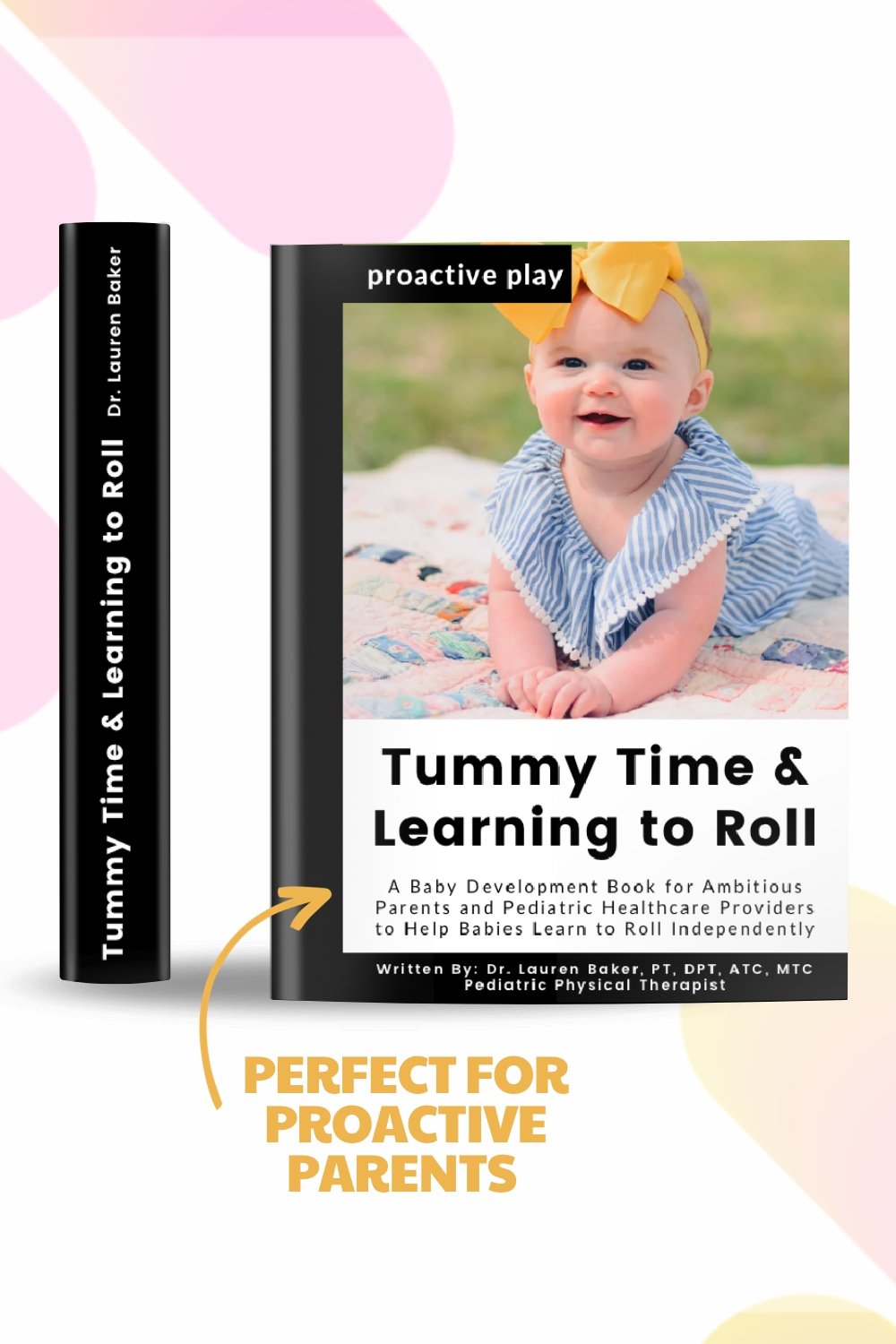When Should Babies Roll Over?
this blog contains affiliate links
Hey there 👋 parents and caregivers! I'm Dr. Lauren Baker, your go-to pediatric physical therapist, and today, I'm diving into a topic that many of you have asked about: When should your baby start rolling over?
I'm excited to share everything you need to know to support your baby's developmental journey, so let’s roll ;)
Understanding the Rolling Milestone
Rolling over, both from the belly to back and back to belly, is a significant milestone in your baby's development. It marks the beginning of your little one exploring the world around them in a whole new way. But when exactly should this happen?
Here's the scoop:
Belly to Back: Typically, babies master this skill within the 3 to 5-month age range.
Many find the motivation to roll out of tummy time a tad earlier since tummy time can be quite the challenge!
If this is the case, it wouldn’t be atypical for babies to do this in the beginning when tummy time is really really tough and then go a bit without doing it. That would indicate that without the tummy time difficulty motivation, the baby isn’t sure how to complete the motion, indicating it is not yet mastered.
Other times, babies roll from belly to back without controlling the movement and they can bang their head on the ground, this usually indicates an underlying tightness or relaxation difficulty while they are completing the motion.
Back to Belly: This one usually comes a bit later, around the 4 to 6-month mark. It requires a bit more core strength, coordination, and flexibility, as your baby learns to bring both arms to one side to initiate the roll.
They often start rolling back to side first, then once they gain enough strength and coordination they straighten the bottom leg and are able to finish and roll over onto their belly.
If your baby seems to have everything except being able to get all the way onto their belly, check to see if the bottom leg is straight, that might be tripping them up (although, rolling is fairly complex so it could also be more than one thing).
Normal Variation in Rolling is... Normal!
Remember, there's a broad spectrum of normal when it comes to developmental milestones. Typically you will see the style of rolling develop into more complex movement as babies get stronger and their movement improves.
By six months, babies should be able to roll equally in all directions and fluidly without any stiffness noted. Stiffness or underlying muscle (usually trunk) tightness would be present if a baby didn’t seem to be twisting at the trunk (think top half of the body moves in different directions than the bottom half of the body) during rolling (belly to back and back to belly).
Early Rollers: What to Watch For
Seeing your baby roll over early can be exciting, but it's also essential to ensure that it's part of healthy development and not due to increased tension in their body or other issues. Here's what you should consider if your baby is showing signs of rolling and they are younger than four months.
Increased Tension: Sometimes, early rolling (less than 4 months) can indicate tension in the muscle or fascial layers. Keep an eye out for signs of discomfort or stiff movements.
Feeding Concerns: Issues like tethered oral tissues (tongue-tie) can sometimes accompany early rolling. If you notice feeding difficulties alongside early rolling, consulting with a lactation consultant, occupational feeding therapist, and/or a pediatric physical therapist might be a good idea.
Supporting Your Baby's Rolling Skills
Helping your baby develop the strength and coordination for rolling is all about creating opportunities for movement and play. Here's how you can encourage them:
Tummy Time: Regular tummy time is crucial for strengthening the muscles needed for rolling. Aim for a few minutes at a time, several times a day. This is important to build up from a few minutes to 5-10 by the time they are 4-5 months.
The most important aspects of tummy time are these:
Is their head up to 90 degrees (perpendicular to the floor) and able to rotate over their shoulder in both directions
Are they pushing through both elbows equally to lift their chest off the floor
By five months, babies should be strong enough to push onto extended elbows, but they might not if they haven’t been pushing equally through both elbows in their earlier months. Elbows out to the side or back (Landau reflex and totally normal if not interfering with rolling) might not help babies move onto their next milestone.
Engage and Play: Use toys and engaging activities to encourage your baby to reach, stretch, and eventually roll over in pursuit of an interesting object. Reaching forward is good, reaching to the side is even better (but also harder, so start with toys in front first!).
Observe and Support: Watch for signs of readiness to roll, and gently encourage the movement. Babies should get lots of time to play on their own, but parents should never feel like helping their babies move is going to inhibit their ability to learn.
Resources at Your Fingertips
If you're looking for detailed strategies, exercises, and more insights into helping your baby master rolling (and beyond), my book has you covered. It's designed to be a comprehensive resource for parents eager to support their baby's development effectively.
What If My Baby Isn't Rolling Yet?
If your baby hasn't started rolling by six months, it's a good idea to consult with a pediatric physical therapist. An individualized session can help pinpoint any areas your baby might need a bit more support in, ensuring they're on track for healthy development.
If a baby is not rolling in all four directions by six months, there is also likely an underlying block that is keeping them from doing so and consulting with a Pediatric Physical Therapist who specializes in infants can help uncover those blocks.
If you’d like to start trying to uncover what is going on, the book has three checklists: tummy time, rolling back to belly, and rolling belly to back to help you narrow down what might be the struggle for your baby and help you get started in the right areas.
Curious About Learning More on Tummy Time, Rolling, or Both?
The absolute best book for parents on tummy time and rolling is: Tummy Time and Learning to Roll: A Baby Development Book for Ambitious Parents and Pediatric Healthcare Providers to Help Babies Learn to Roll Independently. The book comes with a free online video course to help parents fully understand how to complete the different exercises, printable checklists to know exactly where your baby is at, and when to reach out for additional help.
This book was written by Dr. Lauren Baker, PT, DPT, ATC, MTC, who is a Pediatric Physical Therapist in Boise, Idaho, trained in helping parents learn how to help their babies move and master their milestones. She loves teaching parents how to see how their babies are moving as well as how to influence those movements though play positions and exercises to help babies move with confidence and ease.
Tummy Time and Learning to Roll is the first book in the Proactive Play series written by Pediatric Physical Therapist Dr. Lauren Baker in order to help Ambitious Parents and Pediatric Healthcare Providers learn how to help babies master tummy time and learn to roll. It is meant to help ambitious parents understand baby development from birth to six months (tummy time to rolling).
This book is a mix of easy-to-follow and more in-depth information than is typically found in baby development books because Dr. Baker believes parents deserve to have all the information at their fingertips.
This book breaks down each piece of movement in checklists so that parents know what their babies need for tummy time and rolling. It also covers what areas might limit a child with rolling, why it is so important, and when to seek help from a pediatric PT.
This book comes with colored photos and easy-to-follow demonstration videos that can help parents implement safe, strategic play-based exercises with their babies in 20 minutes per day.
A Great Resource For:
Parents and Pediatric Healthcare Providers of babies 0-6 months
Parents of babies who are struggling with tummy time, rolling back to belly, belly to back, or only to one side
Access to simple, easy-to-follow videos of play positions and exercises
Learning the four pillars of movement needed in order to master rolling
240+ Color Photo Examples of:
Tummy Time, Sidelying, and Back Play
Developmental Toys and Equipment
Hand Placement and Strategic Play Positions
Common Areas of Restriction or Weakness
When To Reach Out For Help
What If You Want Extra Help?
If you have concerns about their movement, remember, you can always reach out to a pediatric physical therapist. It's your right as a parent to advocate for your child's development.
Sometimes, a few tips and tricks are all you need to get your baby moving better. We're here to support you and release those mama worries. If you are looking for in home pediatric physical therapy, check our listing of therapists.
For those eager to learn more or seeking personalized guidance, I offer online video parent consultations internationally which can be scheduled by clicking here. I am dedicated to answering questions and providing tailored play activities for each unique developmental journey.
When Should Babies Receive Pediatric Physical Therapy?
Parents can call and schedule with a Pediatric Physical Therapist at any time, for any concern in all fifty states without a referral from their Pediatrician.
Pediatric Physical Therapy is medically indicated in all babies who are not rolling in all four directions by six months (back to belly over their right arm AND left arm + belly to back over their right arm AND left arm).
Pediatric Physical Therapy is medically indicated if you notice a flat spot on the back of an infants head (possible plagiocephaly), a tilt of their head consistently to one side (ear to shoulder - possible torticollis), or a rotation preference of their neck (consistently look only to the right or left - possible torticollis).
Many Pediatric Physical Therapists including Dr. Baker, can successfully treat flat spots (Plagiocephaly) without a helmet with a combination of therapy and positioning strategies if seen prior to 4 months (0-3 months is ideal). Dr. Baker uses the Baby Begin Method of repositioning.
Flat spots can be due to in-utero positioning, rotational preference (right sided flatness most common) and babies are at an increased risk for flatness if they are male, were breech, multiple birth, premature, have difficulty with tummy time, or are in containers > 2 hr/day.
Final Thoughts: The Journey
Remember, rolling over is just one of the many milestones in your baby's incredible journey of growth and learning. By providing supportive and engaging environments, you're setting the foundation for their continued exploration and development.
If you have any questions or if there's more you'd like to know about baby development, feel free to drop a comment in the video linked above. I'm here to support you and your little one every step of the way!
Until next time, keep rolling forward, and cherish these beautiful moments of growth and discovery with your baby.







